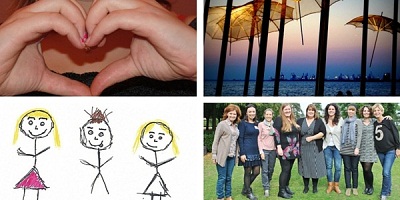Coping under pressure: UN research into children who experience domestic violence
Date 12.11.2015

Research led by the University of Northampton has found that children who experience domestic violence are not just passive observers – they find complex, creative ways to manage and cope with what they have experienced, and have the capacity to be strong and resilient.
This is a key finding of the research project ‘Understanding Agency and Resistance Strategies – Children in Situations of Domestic Violence’, which today has published its final project report. This two year project, funded by the European Commission and led by the University of Northampton’s Dr Jane Callaghan, is the largest qualitative study of children’s experiences of domestic violence conducted in the world.
To collate the data, researchers in Greece, Italy, Spain and the UK interviewed 110 children and young people who had experienced domestic violence, focused on how they experienced the violence, and how they found ways to manage their experiences. Using the insights gained from this research, the team developed a group-based therapeutic intervention to support children to build on their existing strengths and coping strategies. The intervention aims to help the young people develop resilience and a positive sense of self, as they recover from living with domestic violence.
Dr Jane Callaghan explained: “We should challenge the media’s depiction of children who experience domestic violence, as they are often portrayed as passive, helpless victims, doomed to repeat cycles of violence in their own later relationships. From our research we have found that children’s experience of domestic violence is a little like a double helix, with the twin strands of coping and damage very closely interlinked. Children’s capacity to be strong, to be agentic, to be resilient can only be read in the context of the actions that function to undermine their development of agency and resilience, forms of relating that characterise violence, abuse and coercive control.”
Jane continued: “Consider, for instance, the examples of children hiding away in cupboards, hidey holes and dens. In some senses this looks like an accession to abuse and control – children might be seen by professionals and academics as hiding away, as cowering in corners. But if we only see this painful and difficult aspect of the child’s behaviour, and don’t try to make sense of the meaning they attach to it, we do not see how it is also resistant and resilient. Children are not just frightened, they are not just hiding. They are creating spaces for themselves, where they can feel just slightly safer, just a little more secure and in control.”
The research team also completed an analysis of European and national policies on domestic violence. Their most significant finding is that children are startlingly absent from legal and policy frameworks. Dr Callaghan explained: “Children who ‘witness’ domestic violence do not have a legal status as ‘victim’ – although this is changing in Spain, where the distinction between ‘direct’ and ‘indirect’ victims is being removed from Spanish statutes. This means that children are seen in law and policy as an absence, as ‘collateral damage’ to adult domestic violence, and this has consequences for how they are understood and treated in criminal justice, social services and voluntary sector organisations. Services for children who experience domestic violence are typically a ‘bolt on’ to adult oriented services, as adults, and particularly women, are seen as its main victims.”
“We think this is because children are seen as ‘silent witnesses’, helpless in families where domestic violence occurs”, says Dr Callaghan. “By focusing on children’s voice, on their capacity to make sense of the situation they are in, and to take creative action to make their lives a little better, we have been able to highlight both the profound impact of violence on children’s lives and the complex and often paradoxical ways that they find to cope.”
The UNARS project has highlighted that children experience the negative impact of domestic violence, and cope with domestic violence, in much the same way that adult victims do, and that the distinction between ‘direct’ and ‘indirect’ victim, or between ‘adult victim’ and ‘child witness’ is not sustainable. When policy frameworks do not include children as victims, this contributes to the erosion of children’s representation and voice in professional and policy discourses. By focusing on children’s capacity for conscious meaning making and agency in relation to their experiences of domestic violence, the research team have highlighted the importance of recognising the impact domestic violence has on children, and their right to representation as victims in the context of domestic violence.
To learn more about the research, and to read the research report, visit the UNARS website. You can also view a short video, based on the interviews, as well as drawings and photos that the children contributed to the project (a selection are shown above). To discuss this research, or the experiences of children who live with domestic violence, please contact Dr Jane Callaghan via email or phone 01604 893268. To find out more about the University of Northampton’s courses in Psychology, visit out Psychology subject hub.
—
Pictured: children’s artworks and photographs which they contributed to the project, and the UNARS team from accross the four countries.